
Last Saturday I was attending a group put together by Tim Stevenson at Martha Carpenter’s studio in Tuscumbia. For my friends from outside of this area Tim and Martha are two well established artists here in the Shoals area. Because I am an art nerd I kind of consider both of them celebrities in my universe, and I am always honored to just be in the same room with them.
Anyway, twice a month Tim has a roundtable discussion with a group of artists, many of whom are there for his instruction that follows these talks. I affectionately refer to them as “Tim Talks.” Last Saturday Tim mentioned his practice of always finding at least one thing during his day that he can take with him to contemplate on at the end of the day. In this context he mentioned how he does this in every art museum he visits as well, and encourages young people to do the same.
As I sat listening it occurred to me that I have often done the same in most museums I’ve visited, even if only subconsciously. There was one museum visit for me, however, that planted an image in my mind I have not been able to shake for the last 26 years. In May of 1998 I was in Brussels, Belgium. I spent an entire day at the Musées royaux des Beaux-Arts de Belgique. While there are amazing paintings by all the greatest masters within its walls my main focus was to see “La Mort de Marat” by Jacques-Louis David, but that would not be the image that followed me home all the way back to America that still haunts me to this day.
As I casually turned a corner in another part of the museum I was met by one of the most startling paintings I’ve ever seen. A life-sized image of a woman’s severed head hanging by her hair from a knife stuck into a wooden wall with large words written manically above it that read, “Vive la Mort.” Below was written, “A mon ami Fernand Nauts, Jan van Beers, 1873.” As I stood there in shock a woman and her daughter walked up next to me. Equally shocked, the woman grabbed the cross around her neck and kissed it, then crossed herself.
This is not a famous painting, and Jan van Beers is not a particularly famous artist outside of Brussels or an art school classroom, so trying to find out more about this work wasn’t very easy. The best I have been able to figure out is there was an artist named Fernand Khnopff, who was a contemporary of Beers in Brussels at that time. Although more known for his paintings Khnopff was also a writer and critic who mentions Beers in some of his writings. In one place he seems to cast some shade on van Beers by referring to him as a “Parisianised Belgian artist.” [1]
In another article he writes, “Just at this time Jan van Beers, the wayward painter of ultra-Parisian whimsicalities, and J. Lambeaux, the powerful sculptor of Flemish grossièretés, simultaneously terminated their studies at the Antwerp Academy. Jan van Beers was already attracting attention by his exuberant independence of spirit and by eccentricities that had become notorious. He made great friends with Struys, whom he persuaded to join him in a studio he had taken in the heart of Antwerp. In 1871, while still attending the higher classes at the Academy, Struys had exhibited A Young Girl returning from School in the Salon at Ghent; in Jan van Beers’ studio he painted a series of humorous pictures, facile and ordinary in character, which obtained no greater success with the public than did the extravagances which his friend invented in order to attract the notice of buyers.” [2]
He goes on to rake van Beers and his friend over the coals for the rest of this article, and while these things were written in 1901 and 1907 respectively, I can’t help but wonder if some amount of animosity had always existed between Khnopff and Beers.
Is it possible that this painting was directed as an attack at Khnopff? I can’t confirm that, and I wish I could find a scholar that could, but it seems plausible to me. The painting was donated to the museum in 1986 by a Mme E. Nauts-Collart from Uccle, Brussels. As we can see in the painting the person whom Beers addresses as his “friend” is Fernand Nauts, so we can assume Mme Nauts-Collart is a descendant. Given the slight similarity in the pronunciation of both Khnopff and Nauts I can’t help but to wonder if they are connected. Then again, Fernand Nauts may be a completely different person, and if so I would really like to know the story behind this painting and van Beers’ relationship to his “mon ami!” Whether this was meant as an insult or just a humorous jab the words are dripping with sarcasm no matter how you sort them out.
So, here I am 26 years later thinking about one obscure painting I ran into, or should I say ran into me. So next time you walk through a museum be on the lookout for that meaningful moment. Maybe it will be a painting or a sculpture, or maybe it will be a mom chasing after a three year old walking towards a 400 year old masterpiece with peanut butter all over his hands! In my world everything is a painting.
REFERENCES:
[1] Khnopff, Fernand, “Belgian Pen-Drawings,” The Studio, special winter number 1900- 1901, 176-183.
[2] Khnopff, Fernand, “Alexandre Struys, a Belgian Painter,” The Studio, 41, 174 (September 1907), 283-289.
